by Joanne
Wiertella
(click on photos to enlarge image)
AMERICAN ART METAL JEWELRY BOXES 1900-1925
Jewelry boxes have long been treasured, for they have
held precious items -sometimes valuable in themselves, sometimes
valuable for their memories. Throughout history, jewelry boxes
had been constructed and designed by craftsmen, one box at a
time, each a unique piece reflecting the style of the time and
locale.
With the advent of the Industrial Revolution, all this
changed. And as we know, the concept of mass production
was avidly adopted in the United States during the late
19th early 20th centuries. For the first time, metal
objects like jewelry boxes, for example, could be cast
in quantity and, through mail order catalogs (Sears and
Roebuck, Montgomery Ward, Marshall Field), American
ladies of the early 1900’s could aspire to the “high
style” of the world’s great cities like London and
Paris.
Jewel boxes, also called 'caskets', gained great favor
-from the tiniest ring box to the very large
handkerchief and glove boxes. They were made of cast
metal, first plated with copper, then with silver or
gold. They were lined with fine pale-colored silks from
Japan and China, printed faille and satin/sateen, and
were often trimmed with a fine twisted silk cording. |
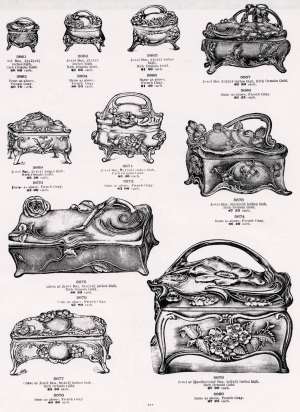 |
| |
Austin N. Clark & Company Jewelry Catalog,
Chicago, IL, 1913
|
The most popular style of these 'Art Metal' jewel boxes
during the early 1900's was Art Nouveau. First the nymph-like
young women with flowing hair appeared. Soon after, flowers and
vines, birds, and other fauna decorated these fanciful boxes.
Floral motifs, in particular, gained great favor, probably due
to the very popular Victorian 'language of flowers'.
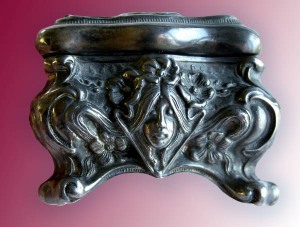 |
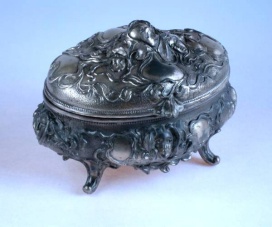 |
|
Mfr. Unknown, 1904, 4 x 3 ½ x 4 in,
Commemorates 1904 Louisiana Purchase Exhibition
in St. Louis, Peacock/Wild Rose on lid, Moon and
Stars on bottom
|
B&W 149 Danbury, Patented Nov.22, 1904,
5 ¾ x 4 ¼ x 4 in,
Iris/Nouveau Portraits
|
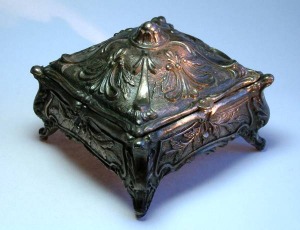 |
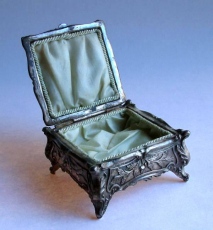 |
|
JB 824 (Jennings Brothers), 1910,
3 ¼ x 3 ¼ x 2 ½ in,
Oak Leaves and Acorns
|
JB 824 (Jennings Brothers), 1910,
Oak Leaves and Acorns
(open)
|
The romanticism of the period also gave rise to revival
styles such a Greek, Roman, Egyptian, Rococo, and so
on--not to mention Americans' reflection on their own
Colonial Days. |
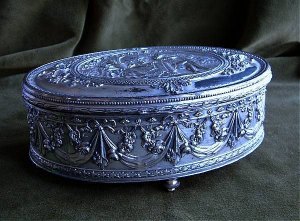 |
| |
JB 2733, 1915+, 8 x 5 ½ x 3 in,
American Colonial scene with Marie Antoinette
ribbons
|
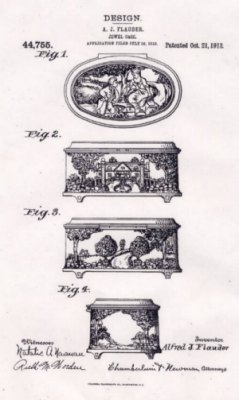 |
There were several American art metal manufacturers that
designed and produced jewel boxes. Jennings Brothers (JB),
Kronheimer & Oldenbusch (K&O), Benedict Mfg. Co.,
N.B.Rogers, and The Art Metal Works. Brainard & Wilson
Corp. (B&W) patented one of the first Art Nouveau
designs in 1904, and Weidlich Brothers (WB Mfg Co) took
several patents and copyrights on their Colonial designs.
|
|
Weidlich Brothers Patent (Drawing), Oct. 21, 1913
|
|
These wonderful antique jewelry boxes were much treasured,
and they held their popularity well until World War I, when the
continuity of fashion was broken, re-directing interest from the
decorative to the function and power of the machine.
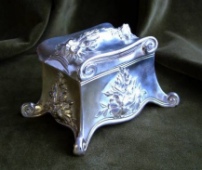 |
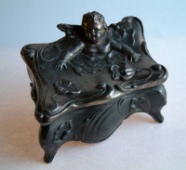 |
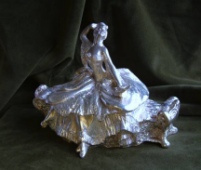 |
K&O, 1906-10,
6 x 4 3/8 x 4 in,
Aster/Daisy/Pinks
|
“NB Rogers 925, 1907,
4 ½ x 3 ½ x 2 ¼ in,
Cherub/Poppy
|
WB 486 (Weidlich Brothers)
Copyright 1912-13,
10 x 5 ¼ x 7 in
|
|
|
|
Baird-North Catalog,
1913, Birth Month broaches show floral motifs
used on jewel boxes
|
- Joanne Wiertella -
photos by Willa Davis
Joanne Wiertella has been
collecting and researching antique American
jewel boxes for nearly 20 years. She has
recently published a book on these lovely
American art metal novelties which pictures her
collection of 500+ Jewel Boxes. The Jewel Box
Book offers inside its full-color, 208 pages, a
wide selection of information including: styles
(Art Nouveau, Victorian, Rococo, Revival);
manufacturers; floral and other motifs pictured
and explained; metal composition and finishes;
period advertising; trademarks, patents, and
copyrights.
More information at
www.jewelboxbook.com |
|
|
 ASSOCIATION OF SMALL COLLECTORS OF ANTIQUE SILVER
ASSOCIATION OF SMALL COLLECTORS OF ANTIQUE SILVER ASSOCIATION OF SMALL COLLECTORS OF ANTIQUE SILVER
ASSOCIATION OF SMALL COLLECTORS OF ANTIQUE SILVER